Someone was killed on the 401. Are these highways really safe?
You are using an out of date browser. It may not display this or other websites correctly.
You should upgrade or use an alternative browser.
You should upgrade or use an alternative browser.
Cycling infrastructure (Separated bike lanes)
- Thread starter MetroMan
- Start date
Skeezix
Senior Member
Member Bio
- Joined
- Apr 25, 2007
- Messages
- 4,343
- Reaction score
- 2,691
- Location
- East of this, west of that
http://www.cbc.ca/beta/news/canada/ottawa/cyclist-struck-lyon-laurier-crash-1.3744035
Someone just got killed on Ottawa's only separated bike lane. Are these bike lanes really safe?
Let's not be misleading. The article to which you linked indicated that the cyclist was killed by a truck at the intersection of Laurier and Lyon, not in a separated portion of the bike lane.
Given this particular article, I would also think we should not be blaming the 20-year cyclist who was killed, but considering whether the truck which struck her, and trucks generally at this intersection, are safe. Years ago I worked a few blocks north of here, and walked through this intersection every day, long before separated bike lanes were installed on Laurier. At 8 a.m. in the morning, when this recent accident occurred, this intersection was full of pedestrians and cyclists even back then. The separated bike lanes are not the problem. The issue is whether trucks can co-exist at peak times with more vulnerable road users, who are equally entitled to use the road allowance.
k10ery
Senior Member
http://www.cbc.ca/beta/news/canada/ottawa/cyclist-struck-lyon-laurier-crash-1.3744035
Someone just got killed on Ottawa's only separated bike lane. Are these bike lanes really safe?
Must be another concern troll bot.
steveintoronto
Superstar
No, not safe enough, which means Ottawa should revisit the design, and consider a concrete curb to separate the lane such that vehicles turning right can't impinge on the cycle lanes. Radius too tight? Then vehicles will have to slow down more. Problem addressed.http://www.cbc.ca/beta/news/canada/ottawa/cyclist-struck-lyon-laurier-crash-1.3744035
Someone just got killed on Ottawa's only separated bike lane. Are these bike lanes really safe?
The same poor design is manifest in the Bloor lanes, and more. Vehicles turning across cycle lanes should be addressed as prescribed in the HTA, at the very least. In the event, I see little choice for safety but for concrete curb barriers for cycle lanes. It won't stop all drivers turning when they shouldn't, but it will stop most.
Until Toronto accepts that, the Bloor lanes will be deemed a 'failure'...and as a design exercise, they've already violated many North Am best practices, let alone European ones.
I've been away for over a week, wondering how many cyclists have been doored from passenger doors from cars parking oblivious to the solid white lines, let alone the bollard joke (drivers seem to think they indicate to park between them, not beside them).
The best stretch on Bloor for cycling? The stretch between Bay and Yonge. Extra wide sidewalks, no pretend cycle lanes, and *no parking*! Sight lines are excellent, sharrows are on the road, and the bulk of drivers have a sense of flow at the right rate, ditto cycling through there.
Some posters had stated some weeks back, as to the best way to cure the new Bloor cycle lanes' problems: "No Parking". I thought it was unrealistic at the time, but not now if a reasonable level of safety is to be achieved. Considering that only 10% of business along the new bike lane stretch is from motorized vehicles, "no parking" appears by far the best way to make the greatest difference. And Bay to Yonge proves it...even without marked bike lanes!
My apologies to those posters I disagreed with on the "no parking" point weeks back. I now think you're right, now it's up to the merchants affected themselves to be heard on the point.
More than any other factor, parking is the one that complicates everything along Bloor, *even for motorists!* No matter what happens, the Bloor lanes have serious issues, and I've not heard a word back from Cressy or Layton, any of their staff, or even any mention in the press since the first week of operation as to how the lanes were working. Every time I've visited them, the level of danger varied, but they were/are still dangerous.
Last edited:
steveintoronto
Superstar
This is my second reply to this, because I'm just just sat down to read the Financial Times, and lo and behold, they have an extensive multi-diagramed, illustrated and researched Weekend Magazine article on exactly this point. And to allow everyone to read it, this article is *non-subscription*! (illustrations removed to conserve text copy limit)http://www.cbc.ca/beta/news/canada/ottawa/cyclist-struck-lyon-laurier-crash-1.3744035
Someone just got killed on Ottawa's only separated bike lane. Are these bike lanes really safe?
https://ig.ft.com/sites/urban-cycling/Is urban cycling worth the risk?
FRIDAY, 2 SEPTEMBER 2016
If you live in a big city, you may have thought about cycling to work. You will have weighed up the pros and cons: the health benefits, the low cost, the speed – versus the fact that you might be hit by an 18-tonne articulated lorry. On balance, you may have decided you didn’t want to take the risk.
You would be in the majority. In 2014, 64 per cent of people surveyed by the UK’s Department of Transport said they believed it was too dangerous for them to cycle on the road. These decisions are often based on gut feelings or anecdote: a friend who has had a great experience commuting by bike can inspire us to follow suit, while seeing or hearing about a bad cycling accident may put us off for life.
Such experiences are important. But what do the data say? As cities grow busier, obesity levels rise and climate change becomes a more pressing concern, we asked the FT’s transport correspondent and two of our specialist data journalists to investigate the risks and benefits of commuting by bike in big cities, something all of them do regularly. Here they give us their verdict: is it worth it?
Death and accidents
by Robert Wright, FT transport correspondent
When a new cycle superhighway opened along London’s Blackfriars Road this year, a long-standing danger was removed. The traffic lights were phased so that cyclists didn’t have to go through the junction at the same time as motor vehicles.
Nine cyclists died riding in London in 2015, all of them hit at intersections, highlighting the concentration of danger at these key pressure points. The designers of London’s new cycle superhighways have made safer junctions a priority. Transport for London, the government agency responsible for the capital’s transport system and the creator of superhighways, is also pushing truck operators to introduce new types of lorry with better visibility, because big trucks are involved in a disproportionately high number of crashes affecting cyclists.
These steps are typical of the efforts under way across the industrialised world to make urban cycling safer. Policy makers hope that, by providing better spaces for cyclists to use, they can encourage the growth of a clean, low-cost transport mode that will take some strain off existing transport systems.
“What we know is that the single biggest thing which deters non-cyclists from cycling is the fear of being injured by a car or a lorry,” says Ben Plowden, a senior director of planning at TfL.
Mile by mile, people in the UK are actually more likely to die walking than cycling, according to figures from the Department for Transport. For every billion miles cycled last year, 30.9 cyclists were killed, while 35.8 pedestrians were killed for every billion miles walked. Both activities are significantly safer than riding a motorbike – 122 motorcyclists are killed for every billion miles driven.
Of more concern are the statistics around injury. The UK’s overall casualty rate for cyclists, a broader measure which counts serious injuries and slight injuries as well as deaths, was around 5,800 per billion miles in 2015, not far off the casualty rate for motorcyclists – and almost three times higher than the 2,100 per billion miles for pedestrians. As well as cutting the fatality rate, TfL hopes its safety improvements can reduce the rate of injuries.
The front rank of cycle-safe cities worldwide are in northern Europe. City Cycling, published in 2012 and edited by John Pucher and Ralph Buehler, calculated the average number of annual cyclist deaths over the previous five years for every 10,000 daily cycle commuters in big European and American cities. London, with an average of 1.1 deaths per 10,000 commuters, fared better than New York’s 3.8. But both lagged far behind the 0.3 annual average deaths in Copenhagen and 0.4 in Amsterdam.
Simon Munk, infrastructure campaigner for the London Cycle Campaign, says the evidence suggests cycling is higher in cities with safe, segregated lanes and well-designed junctions. While cyclists in London still enjoy only patchy areas of segregation from traffic, their counterparts in Amsterdam and Copenhagen often spend their whole commutes isolated from cars.
Patchy information in the industrialised world makes it hard for statisticians to be more precise than Pucher and Buehler. Data for cities in the developing world – such as Delhi and Beijing – are still more incomplete. “In the cities where people feel under threat, they probably are under threat,” Munk says.
New York and many other world cities are planning similar road improvements to London to increase cycle safety. Paul Steely White, executive director of Transportation Alternatives, a cycle-advocacy group, says his organisation has worked with New York’s Department of Transportation to devise plans for safer junctions. Michael Schenkman, 78, hit in Bayside, Queens, on August 24, became the 16th cyclist to die in New York this year. Such tragic deaths tend to be concentrated, White says, on the city’s periphery, much of which lacks specialist facilities for cyclists, while traffic is heavy and fast-moving.
Some people may never be tempted on to their city’s roads until cycle paths are entirely separate, as in many parts of the Netherlands. In more than 20 years of urban cycling in the UK, I have been knocked off by motor vehicles twice and once by another cyclist. It was only by good fortune that I escaped serious, long-term injury. But the bald facts of those incidents fail to capture anything like the whole, complex picture of the risks I’m taking. Heart disease, cancer, stroke and a tendency to put on weight all pose far more serious risks to my life expectancy than the relatively small risk of a fatal crash.
All forms of transport entail some risk. I was knocked down as a child while crossing a street. I crashed my dad’s car off the road during my first driving lesson. I’ve been caught underground in a subway train during a track fire. Riding a bicycle represents, even under current sub-optimal conditions, a good trade-off between risks and rewards. And as urban design becomes more protective of cyclists, that trade-off can only improve.
[...more sections continue at length...]
Do you cycle to work?
We would like to know what you think about urban cycling. Instagram a photo of you and your bike on your commute, telling us why you choose to travel by bike OR your favourite cycle route, and tag @ft_weekend. We may publish a selection of entries on FT.com
Last edited:
steveintoronto
Superstar
First off: Thank God this young lady didn't get hurt more. This has all the factors for being fatal.
Secondly, there's a technicality I see in this video: The driver was committing a parking offence, but not the one you'd think. He's blocking a roadway, not a cycle lane. He's on top of sharrows. None-the-less, I'm livid on this. This is going to happen time and time again, and Bloor is the one most prone for it to happen. The painted lines and bollards stop *nothing*. It has to be a concrete curb with gaps.
Video is posted at the link and a full length one here:
Secondly, there's a technicality I see in this video: The driver was committing a parking offence, but not the one you'd think. He's blocking a roadway, not a cycle lane. He's on top of sharrows. None-the-less, I'm livid on this. This is going to happen time and time again, and Bloor is the one most prone for it to happen. The painted lines and bollards stop *nothing*. It has to be a concrete curb with gaps.
https://www.thestar.com/news/gta/20...ghlights-danger-of-parking-in-bike-lanes.htmlVideo of cyclist getting ‘doored’ highlights danger of parking in bike lanes
Video shows Chelsea Mobishwash, 25, careening into a pole after being hit by a truck door opening.
Chelsea Mobishwash, a 25-year-old business student, was doored by a person in a truck that was parked in the Adelaide bike lane. The incident happened Aug. 26, 2016, near the intersection of Adelaide St. West and Morrison St. in west downtown Toronto
By BEN SPURRTransportation Reporter
Fri., Sept. 2, 2016
Video of a crunching bicycle crash in downtown Toronto last week is apparent proof that travelling in separated bike lanes is no guarantee of safety for the city’s riders.
The footage, posted online by 25-year-old crash victim Chelsea Mobishwash, captures the moment on Friday, Aug. 26 when she was “doored” by the occupant of a truck parked in a portion of the bike lane on Adelaide St. West., at Morrison St.
The video was shot by a surveillance camera at a nearby store. In it, a person inside the truck can be seen swinging the passenger-side door open just as Mobishwash rides by, sending her careening into a pole and then onto the ground.
In an interview Friday, Mobishwash, a George Brown business student who also works at a robot vacuum company, said the crash is just a blur in her memory. But she remembers that as she approached the truck, she wasn’t sure anyone was inside, and she rang her bell several times just in case.
“I started speeding on by, and as I was going by I felt something collide with me, and to be honest I really had no idea it was the door,” she said. “I just remember feeling really confused as to why I didn’t make it through, I had plenty of space. . . I was in a lot, a lot, a lot of pain.”
Mobishwash said her left arm was gashed by the door, and required six stitches, but luckily no bones were broken. She said she received painful bruises to the left side of her body and her ribs, and a week after the accident it still hurts to breathe. She can barely use her left arm.

Chelsea Mobishwash is seen on Adelaide street west near Spadina where she was hit. (RICHARD LAUTENS / TORONTO STAR) | Dooring is an offence under the provincial Highway Traffic Act, and carries a fine of at least $365 and three demerit points. Smith said police have 30 days after the alleged offence to lay a charge.
Parking in a bike lane is also against city bylaws and carries a $150 fine, but the charge can’t be laid retroactively, according to Smith.
Jared Kolb, executive director of Cycle Toronto, described the footage of Mobishwash’s crash as “gutting.” He said the incident is evidence that the city needs to revisit the design of its separated bike lanes, which mostly rely on “flexi-posts” to provide a physical barrier between bicyclists and car traffic.
The posts, which have been used on separated bike lanes on Adelaide, Richmond St., and Bloor St., have gaps between them and “are not working to keep motor vehicles out of the bike lanes. That’s something we see repeatedly,” Kolb said.
The lane on Adelaide, like those on Bloor and Richmond, have been installed on a pilot project basis.
According to the city’s manager for cycling infrastructure, Jacquelyn Hayward Gulati, monitoring of Adelaide has shown that the flexi-posts “reduce illegal stopping and parking within the cycle tracks.”
In an emailed statement, Gulati pointed out that the city has installed other forms of separation, like planters, on some parts of its bikeway network. “Improving road safety is one of the city's key objectives,” she said.
Video is posted at the link and a full length one here:
Last edited:
Tuscani01
Senior Member
steveintoronto
Superstar
[
I might erase this when my temper simmers down, but right now, I know what will get the media's attention on this (and the City's) :
A *Bollard Burning!*
Entering "cycling lane curbs" into Google shows a litany of great results. Here's two:
https://a.fastcompany.net/multisite...how/2014/02/3025799-slide-barcelona-spain.jpg
http://farm8.staticflickr.com/7271/7684952522_943afed9e0.jpg
Excellent! Even if that's not exactly what could be used, it's the gist of what could be. Bollards as is are a sick joke...pardon me, ...a *killing* joke.Doesn't even need to be a concrete curb. I saw these used in Madrid to create bus lanes last year. They'd be effective as bike lanes too, and simply need to be screwed into the ground just like bollards, so not much work or cost.
I might erase this when my temper simmers down, but right now, I know what will get the media's attention on this (and the City's) :
A *Bollard Burning!*
Entering "cycling lane curbs" into Google shows a litany of great results. Here's two:
https://a.fastcompany.net/multisite...how/2014/02/3025799-slide-barcelona-spain.jpg
http://farm8.staticflickr.com/7271/7684952522_943afed9e0.jpg
Last edited:
steveintoronto
Superstar
These Recycled Plastic Dividers Can Create A Bike Lane In A Second
The Armadillo is just a small, gentle bump that reminds cars to stay out of cyclists' turf. Easy and cheap to install, it could help more cities take the extra step toward more complete streets.
https://www.fastcoexist.com/3025799...c-dividers-can-create-a-bike-lane-in-a-second
I dunno, what if Toronto Roads Dep't can't read the instructions?
The Armadillo is just a small, gentle bump that reminds cars to stay out of cyclists' turf. Easy and cheap to install, it could help more cities take the extra step toward more complete streets.
- 01/10
Painted bike lanes are safer for cyclists. Even better? Lanes separated with a curb.
" data-slick-index="0" aria-hidden="true" tabindex="-1" role="option" aria-describedby="slick-slide00" style="box-sizing: border-box; margin: 0px; padding: 0px; border: 0px; font-style: inherit; font-variant: inherit; font-weight: inherit; font-stretch: inherit; font-size: inherit; line-height: inherit; font-family: inherit; vertical-align: baseline; float: left; height: 472.469px; min-height: 1px; display: block; position: relative; outline: 0px; width: 720px; left: 0px; top: 0px; z-index: 998; opacity: 0; transition: opacity 500ms linear;">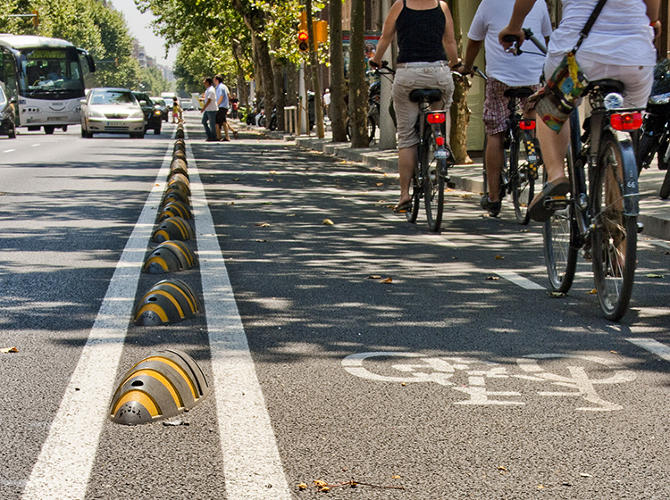
- 02/10
With the "Armadillo," one U.K. design firm aims to help convince more city governments to take the extra step of separation.
" data-slick-index="1" aria-hidden="true" tabindex="-1" role="option" aria-describedby="slick-slide01" style="box-sizing: border-box; margin: 0px; padding: 0px; border: 0px; font-style: inherit; font-variant: inherit; font-weight: inherit; font-stretch: inherit; font-size: inherit; line-height: inherit; font-family: inherit; vertical-align: baseline; float: left; height: 472.469px; min-height: 1px; display: block; position: relative; outline: 0px; width: 720px; left: -720px; top: 0px; z-index: 998; opacity: 0; transition: opacity 500ms linear;">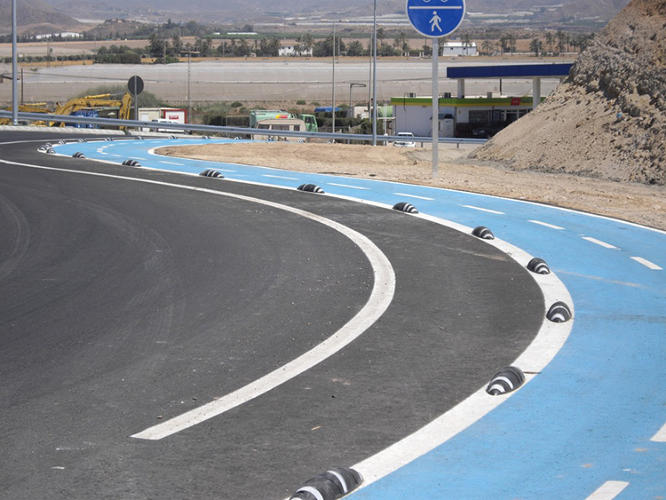
- 03/10
The “Armadillo” is a low-slung recycled plastic bump that can be installed along the edge of a bike lane.
" data-slick-index="2" aria-hidden="true" tabindex="-1" role="option" aria-describedby="slick-slide02" style="box-sizing: border-box; margin: 0px; padding: 0px; border: 0px; font-style: inherit; font-variant: inherit; font-weight: inherit; font-stretch: inherit; font-size: inherit; line-height: inherit; font-family: inherit; vertical-align: baseline; float: left; height: 472.469px; min-height: 1px; display: block; position: relative; outline: 0px; width: 720px; left: -1440px; top: 0px; z-index: 998; opacity: 0; transition: opacity 500ms linear;">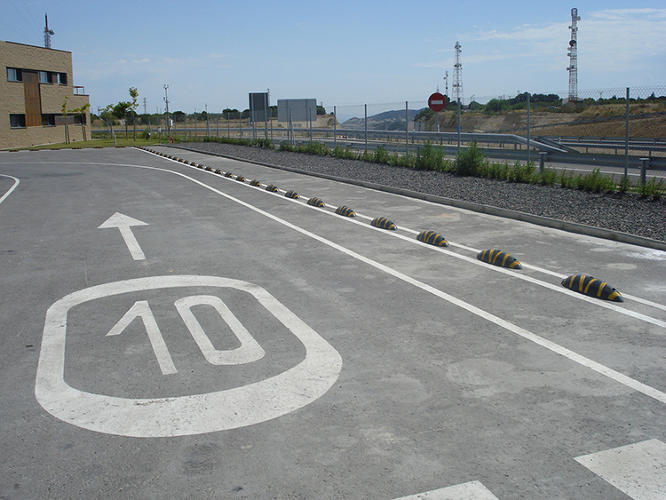
- 04/10
Set at an angle, the bumps allow enough space for bikes to ride back out into the street if they need to, something that isn’t as easy with a full concrete curb.
" data-slick-index="3" aria-hidden="true" tabindex="-1" role="option" aria-describedby="slick-slide03" style="box-sizing: border-box; margin: 0px; padding: 0px; border: 0px; font-style: inherit; font-variant: inherit; font-weight: inherit; font-stretch: inherit; font-size: inherit; line-height: inherit; font-family: inherit; vertical-align: baseline; float: left; height: 472.469px; min-height: 1px; display: block; position: relative; outline: 0px; width: 720px; left: -2160px; top: 0px; z-index: 998; opacity: 0; transition: opacity 500ms linear;">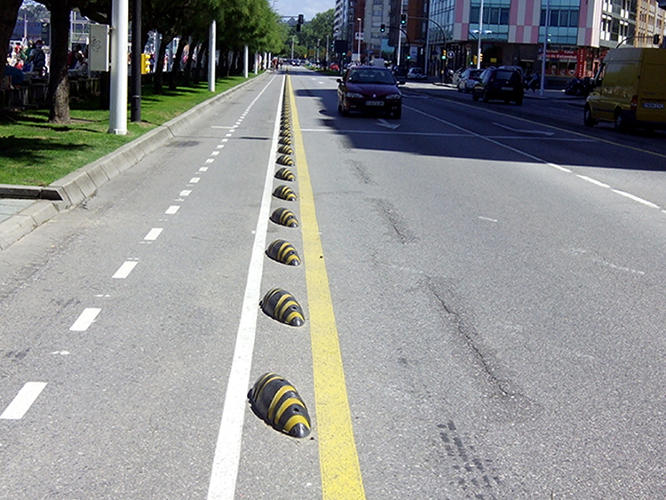
- 05/10
But it still keeps cars out.
" data-slick-index="4" aria-hidden="false" tabindex="0" role="option" aria-describedby="slick-slide04" style="box-sizing: border-box; margin: 0px; padding: 0px; border: 0px; font-style: inherit; font-variant: inherit; font-weight: inherit; font-stretch: inherit; font-size: inherit; line-height: inherit; font-family: inherit; vertical-align: baseline; float: left; height: 472.469px; min-height: 1px; display: block; position: relative; outline: 0px; width: 720px; left: -2880px; top: 0px; z-index: 999; opacity: 1;">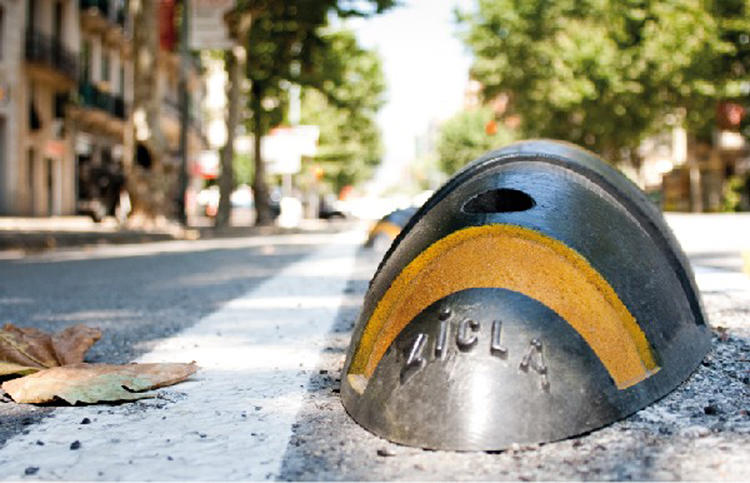
- 06/10
It’s a gentler reminder to drivers than a concrete curb, says Anthony Lau, managing director at Cyclehoop.
" data-slick-index="5" aria-hidden="true" tabindex="-1" role="option" aria-describedby="slick-slide05" style="box-sizing: border-box; margin: 0px; padding: 0px; border: 0px; font-style: inherit; font-variant: inherit; font-weight: inherit; font-stretch: inherit; font-size: inherit; line-height: inherit; font-family: inherit; vertical-align: baseline; float: left; height: 472.469px; min-height: 1px; display: block; position: relative; outline: 0px; width: 720px; left: -3600px; top: 0px; z-index: 998; opacity: 0;">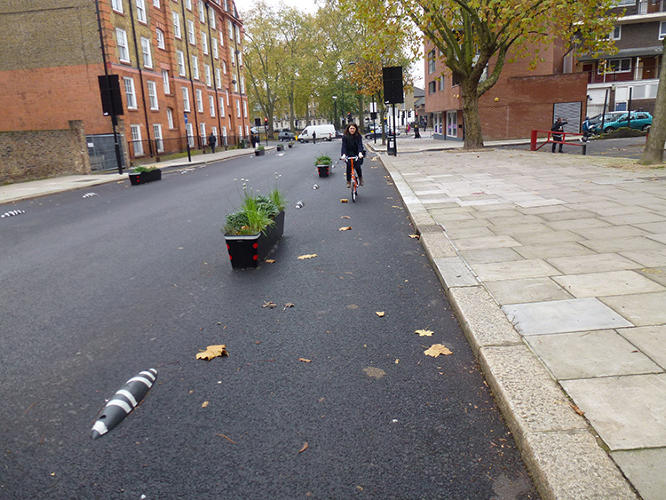
- 07/10
“They’re not very high, so if a driver strays in the road they’ll just feel a bump and move away from the edge."
" data-slick-index="6" aria-hidden="true" tabindex="-1" role="option" aria-describedby="slick-slide06" style="box-sizing: border-box; margin: 0px; padding: 0px; border: 0px; font-style: inherit; font-variant: inherit; font-weight: inherit; font-stretch: inherit; font-size: inherit; line-height: inherit; font-family: inherit; vertical-align: baseline; float: left; height: 472.469px; min-height: 1px; display: block; position: relative; outline: 0px; width: 720px; left: -4320px; top: 0px; z-index: 998; opacity: 0;">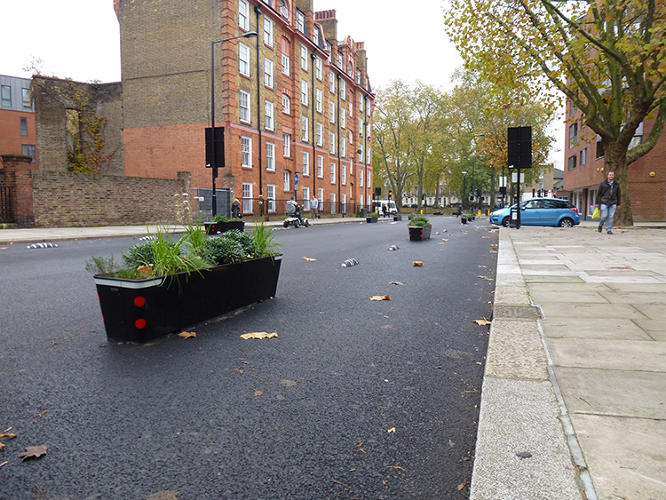
- 08/10
"It’s not like driving over concrete, which would just destroy your wheel.”
" data-slick-index="7" aria-hidden="true" tabindex="-1" role="option" aria-describedby="slick-slide07" style="box-sizing: border-box; margin: 0px; padding: 0px; border: 0px; font-style: inherit; font-variant: inherit; font-weight: inherit; font-stretch: inherit; font-size: inherit; line-height: inherit; font-family: inherit; vertical-align: baseline; float: left; height: 472.469px; min-height: 1px; display: block; position: relative; outline: 0px; width: 720px; left: -5040px; top: 0px; z-index: 998; opacity: 0;"> - 09/10
The recycled plastic dividers are also cheaper than concrete.
" data-slick-index="8" aria-hidden="true" tabindex="-1" role="option" aria-describedby="slick-slide08" style="box-sizing: border-box; margin: 0px; padding: 0px; border: 0px; font-style: inherit; font-variant: inherit; font-weight: inherit; font-stretch: inherit; font-size: inherit; line-height: inherit; font-family: inherit; vertical-align: baseline; float: left; height: 472.469px; min-height: 1px; display: block; position: relative; outline: 0px; width: 720px; left: -5760px; top: 0px; z-index: 998; opacity: 0;"> - 10/10
Workers just drill a few holes to put one in, and a team of three people can install about 100 meters in a day.
" data-slick-index="9" aria-hidden="true" tabindex="-1" role="option" aria-describedby="slick-slide09" style="box-sizing: border-box; margin: 0px; padding: 0px; border: 0px; font-style: inherit; font-variant: inherit; font-weight: inherit; font-stretch: inherit; font-size: inherit; line-height: inherit; font-family: inherit; vertical-align: baseline; float: left; height: 472.469px; min-height: 1px; display: block; position: relative; outline: 0px; width: 720px; left: -6480px; top: 0px; z-index: 998; opacity: 0;">
- 01 /10
Painted bike lanes are safer for cyclists. Even better? Lanes separated with a curb.
- 02 /10
With the "Armadillo," one U.K. design firm aims to help convince more city governments to take the extra step of separation.
- 03 /10
The “Armadillo” is a low-slung recycled plastic bump that can be installed along the edge of a bike lane.
- 04 /10
Set at an angle, the bumps allow enough space for bikes to ride back out into the street if they need to, something that isn’t as easy with a full concrete curb.
- 05 /10
But it still keeps cars out.
- 06 /10
It’s a gentler reminder to drivers than a concrete curb, says Anthony Lau, managing director at Cyclehoop.
- 07 /10
“They’re not very high, so if a driver strays in the road they’ll just feel a bump and move away from the edge."
- 08 /10
"It’s not like driving over concrete, which would just destroy your wheel.”
- 09 /10
The recycled plastic dividers are also cheaper than concrete.
- 10 /10
Workers just drill a few holes to put one in, and a team of three people can install about 100 meters in a day.
https://www.fastcoexist.com/3025799...c-dividers-can-create-a-bike-lane-in-a-second
I dunno, what if Toronto Roads Dep't can't read the instructions?
UserNameToronto
Active Member
OK, new topic:
Toronto's newest cycle path must be Bayview Ave from Rosedale Valley Road to Pottery Road. The paving finished up last week, and the connection to the east side Don Valley trail via a new pedestrian bridge is to be completed this autumn.
I found the trail surprisingly narrow with a few misplaced hydro poles in the trail itself. It seems as though there will be some sort of barrier between the roadway and the cycle path (right now there are just a bunch of large orange pylons). However, it is much better than nothing and helps connect the Brick Works to surrounding neighbourhoods.
The lower Don trail improvements seem to be delayed by complications at the Bala Underpass. Technically the trail is closed, but many were sneaking through the fences just fine.
Toronto's newest cycle path must be Bayview Ave from Rosedale Valley Road to Pottery Road. The paving finished up last week, and the connection to the east side Don Valley trail via a new pedestrian bridge is to be completed this autumn.
I found the trail surprisingly narrow with a few misplaced hydro poles in the trail itself. It seems as though there will be some sort of barrier between the roadway and the cycle path (right now there are just a bunch of large orange pylons). However, it is much better than nothing and helps connect the Brick Works to surrounding neighbourhoods.
The lower Don trail improvements seem to be delayed by complications at the Bala Underpass. Technically the trail is closed, but many were sneaking through the fences just fine.
mdrejhon
Senior Member
These lanes need to adopt a lot of #VisionZero practices.http://www.cbc.ca/beta/news/canada/ottawa/cyclist-struck-lyon-laurier-crash-1.3744035
Someone just got killed on Ottawa's only separated bike lane. Are these bike lanes really safe?
Including traffic light bike-safety-optimized timings to make left/right turns red/illegal until bikes have gone ahead. Currently, these don't.
mdrejhon
Senior Member
Bravo - hear, hear!These Recycled Plastic Dividers Can Create A Bike Lane In A Second
[...]
I dunno, what if Toronto Roads Dep't can't read the instructions?
But don't forget modified traffic lights phases that is green straight ahead for bikes -- but red for turning cars -- and also modified intersection layouts that improves pedestrian and bike safety.
Certainly not for all lights in GTHA but at least for lights with protected bike lanes (and high-traffic cycle lanes like College).
steveintoronto
Superstar
The lights would go a long way...provided both motorists and cyclists observe them...to addressing a lot of dangers. But Toronto is unwilling to do it right.These lanes need to adopt a lot of #VisionZero practices.
Including traffic light bike-safety-optimized timings to make left/right turns red/illegal until bikes have gone ahead. Currently, these don't.
A lady friend asked me yesterday about cycling to school (she teaches), and I thought long and hard about it, she's not assertive of her rights, and not edgy enough to react to the constant stream of dangers. I had to say that I thought it unwise, I'm going to cycle the area of her probable route today to look for parks and safer back streets to do it. The streets *are not* safe for cyclists, by any means, and it's usually the most innocent who get whacked, like the dooring on Adelaide last week. She thought ringing her bell would alert anyone in the truck to her presence. She did it completely by the books, and got creamed. That truck should have alerted every sixth sense, parked incorrectly (not in a bike lane, but impinging on the sharrows, and blocking an intersection)...but easy for me to say that, I'm assertive if not aggressive. And a bell does dick in a situation like that. It shouldn't have to be that way, but as it stands, the roads and cycle lanes are dangerous.
Until lights are instituted (a long time to come in this city) the "plastic dividers" present a solution that the City can't deny. And they're *cheaper* than concrete barriers!
I'm more than a little pizzed at Cressy and Layton. They talk a great spiel when the cameras are rolling, and disappear when they're not. Fair-weather "look at us, we're so green and progressive" cyclists.
I checked out the Bloor lanes yesterday after being away over a week. Parked cars still all over the place, a motorbike parked at the required angle, only to jut right into the cycle lane. It's crazy...and so far, not a word from the City. They've thrown their crumbs at the starving masses, and now want us to go away.
The "plastic dividers" are my weapon to get through their doors.
steveintoronto
Superstar
What trail? I just cycled into Toronto from the east, and would have followed the Don River Trail south from Pottery Rd save for your talking of this "newest cycle path". There's nothing there that I could see! And I hit Bayview during rush-hour. Yikes! Had to detour up the other way with the trail towards Mr Pleasant, no way for continuing on Bayview south in those conditions. Ended up coming across town on Dupont...that's punishment for something.OK, new topic:
Toronto's newest cycle path must be Bayview Ave from Rosedale Valley Road to Pottery Road. The paving finished up last week, and the connection to the east side Don Valley trail via a new pedestrian bridge is to be completed this autumn.
I found the trail surprisingly narrow with a few misplaced hydro poles in the trail itself. It seems as though there will be some sort of barrier between the roadway and the cycle path (right now there are just a bunch of large orange pylons). However, it is much better than nothing and helps connect the Brick Works to surrounding neighbourhoods.
The lower Don trail improvements seem to be delayed by complications at the Bala Underpass. Technically the trail is closed, but many were sneaking through the fences just fine.
So where exactly are these paths?
It's on Bayview -- not open for the public yet.





